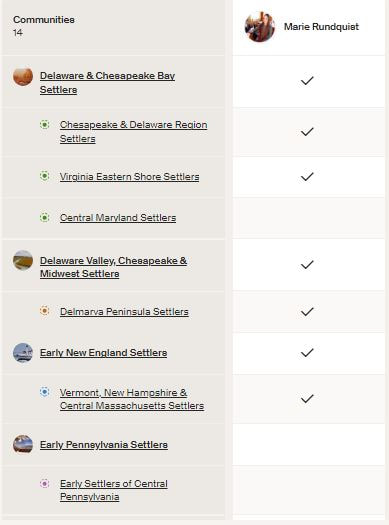|
A Portrait of the Family of Germain Doucet Sieur de Laverdure of France and the 1649 Will of Sieur Charles de Menou d’Aulnay by Deadra Doucet Bourke and Marie Rundquist October 2023 Recently, Deadra Doucet Bourke and I had the occasion to review a number of documents which had been sent to the Acadian Amerindian Ancestry Project by a long-time member. One in particular, originally written in 2019, in draft form, and later updated, concerned the Will of Sieur Charles de Menou d’Aulnay. Named in d’Aulnay’s Will, which was recorded in 1649, was his close friend, Germain Doucet Sieur de Laverdure of France, b. 1595, the military commander of the French fort at Port Royal during Acadia’s earliest days. In his Will, Sieur Charles de Menou d’Aulnay expressed his greatest admiration and generosity towards his true and loyal friend, Germain Doucet of France. By also portraying his family members and their relationships as he did in his Will, d’Aulnay, in a way, framed a “portrait” of the family of Germain Doucet as known to him at the time. Who might d’Aulnay have included when he framed his portrait of the family of Germain Doucet Sieur de Laverdure of France in his Will? But more importantly, who was left out? Referencing the Acadian Amerindian Ancestry DNA Project’s original 2008 finding of a Native American Y DNA haplogroup (C-P39) for a man who traced his patrilineal line to Germain Doucet b. 1641, and the test results of other Doucet men who shared the same ancestor, who were found to belong to the same Native American Y DNA haplogroup, we may exclude Germain Doucet b. 1641 from being the biological son of Germain Doucet of France, or, for that matter, the biological brother of Pierre Doucet b. 1621.
While the DNA results we have in the Acadian Amerindian Ancestry DNA Project help us identify and categorize the different Native American and European Doucet surname lineages represented, as stewards of our heritage, we want to find out more about the “how” and “why” behind these DNA findings and their implications for the family of Germain Doucet Sieur de Laverdure of France. And so, to add to the body of DNA evidence we have about the family of Germain Doucet of France, we share the following information a project member sent to us, in 2019, about the Will of Germain Doucet, Sieur de Laverdure’s close friend, Sieur Charles de Menou d’Aulnay, where the author states (quoting directly from his letter): “… To further complicate the situation, there has been no documentation found to date that even suggests that “Germain Doucet, Sieur de Laverdure” had children of his own. So, in summary, where we find Germain, his wife, a niece, and a nephew clearly identified by d’Aulnay in his Will, which he signed in 1649, we do not find a "son," “Germain Doucet” b. 1641 or, for that matter, another "son," “Pierre Doucet” b. 1621. There were no references to either Doucet in d’Aulney’s Will! Were they to have been Germain’s "sons," as they were clearly in the picture at the time d'Aulnay drafted his Will, surely d’Aulnay, who expressed his great affection for Germain and his concern for the well-being of his wife, his niece, and nephew in his Will, would have made provisions for them. He did not. The DNA evidence we have gathered to-date bears out why: Germain Doucet b. 1641 could never have been the biological son of Germain Doucet of France, and likewise, Germain Doucet b. 1641 could never have been the biological brother of Pierre, born 1621. As we found when we referenced project data, The Y chromosome DNA of their patrilineal, male descendants does not match up! For now, if not at the Louvre Museum in Paris, Sieur Charles de Menou d’Aulnay’s metaphorical portrait of “The Family of Germain Doucet Sieur de Laverdure” which he "painted" so eloquently in the text of his Will in 1649, that includes his friend, Germain Doucet of France, Germain’s wife, and Germain’s niece and nephew, hangs prominently on the wall of the Acadian Amerindian Ancestry DNA Project. We plan to revisit d'Aulnay's portrait of “The Family of Germain Doucet Sieur de Laverdure” from time to time, along with the genealogies, records, and DNA results of our project members, whenever new questions about old ancestors arise. References:
Now that an official announcement in the Northern Virginia Daily about my upcoming presentation to my National Society of the Daughters of the American Revolution (NSDAR) Chapter showed up in my "Google Alerts" this morning, I can say that it is an honor to have been invited to present to my Chapter of the NSDAR this coming Saturday (the calendar is prepared months in advance), and I was delighted to accept.
It is wonderful to participate as a full member of the Chapter and it's great to find so many interests, experiences, and genealogical connections we have in common as a group! As my late father served in the U.S. Military, and I have worked with so many veterans during my career, I am proud to be a part of NSDAR's support of the Wreaths Across America program and NSDAR's service to Veterans, and, with a passion for preserving family histories, the Bible Records Project as well. I look forward to sharing my family's story about Acadian exiles in pre-Revolutionary War Maryland with my NSDAR Chapter here in Virginia. Tailored for the Chapter, I add how DAR Revolutionary War ancestors also tie-into my family story, and how research of DNA matches, family histories and genealogies, have helped me identify ancestors, and verify their lineages. I credit my late grandmother Asselia for her role in arranging events in such a way that I may now tell a story that includes her Acadian and recognized, NSDAR lineages to a NSDAR Chapter, to which I belong, that is located in the town where she was buried. Later in her life, my late, maternal grandmother, Asselia, became a part of a very old, Shenandoah Valley family (the Lichliters) when she married her late husband Cecil, and although I had attended her funeral service at her church in Washington, D.C., back in 1996, I had always wanted to visit her grave here in town. It was because of her late stepdaughter, Beverly Peer, who helped my husband and me locate my grandmother's grave, that we found our property years ago and we have since made our home here. Joanne Poplar inspired me to apply to the NSDAR when I visited the Chapter's booth at the Edinburg, Virginia Festival last year. I had always considered applying because I knew of at least one NSDAR ancestor, and I credit Joanne for giving me the nudge I needed to follow-up (and complete my application). Now, as I dig into the records, I'm finding more Revolutionary War ancestors as well! Thanks again to my Chapter of the NSDAR for inviting me, and looking forward to seeing everyone on Saturday! For information about NSDAR, link to: https://www.dar.org/ Good job with the latest "Communities" update, Ancestry! I could describe how closely the latest Ancestry "Communities" update mirrors my father's deep Eastern Shore / Chesapeake Bay / Delmarva origins (through his Brown, Disharoon, Bounds, Ball, and related ancestors) and my mother's earliest Northeastern / Atlantic Canada roots represented by her wide-ranging Acadian-Amerindian (including Genevieve Hebert, Michel Hebert, Marguerite Gautreau, and Angelique David) and East Coast Beville families. Even better, by using Ancestry's "DNA compare" feature, I could describe how easy it is to find DNA COUSINS who share the same "Communities," as well as long-ago and recent common ancestors! So, how about this: Rather than talking about the latest Ancestry "Communities" update, and how well Ancestry's maps pinpoint the geographic locations of my mom's and my dad's earliest and recent ancestors, I'll simply share an image snip or two from my latest Ancestry communities report, and say, "Spot On!" After all, isn't it true, that "a picture is worth 1000 words?" Please welcome new Administrator, Gordon Lavoie to our Acadian Amerindian Ancestry DNA Project team. Gordon, as a member of the Acadian Amerindian Ancestry DNA Project, is a regular contributor to the dialog on the members-only "Activity Feed" where he frequently responds, in detail, to questions about DNA haplogroups and the genealogical connections among our project members -- with references! While I was writing an email to him, thanking him for his kindness and well-considered responses to our project members' questions on our site, it came to me that I should ask Gordon to join our project as an Administrator. So, I followed my instincts, asked Gordon to join us, and was so delighted when he accepted and then came aboard. As background, Gordon Lavoie was raised in St. Edward, PEI, and after graduating from Tignish Regional High School, he attended the University of Prince Edward Island. Gordon completed his studies at Laval University in 1982 where he earned an honours specialization in Linguistics. Back in PEI, Gordon embarked on a 33-year journey with the Federal Government in a variety of positions, retiring from Public Safety Canada in 2015. Gordon has, and continues to volunteer time on various community organizations and projects. He is currently President of the "Conseil d'administration du Musée Acadien" in Miscouche. Gordon is an avid and experienced genealogist and hosts a database at the Acadian Museum Research Centre which helps 300,000 plus Acadian descendants to connect with their Acadian ancestors, who arrived in Acadia from France some 400 years ago. Most important to new and long-time project members, Gordon is "one of us" and his knowledge of our Acadian - Amerindian lineages, the haplogroups that arise from Acadian Amerindian Ancestry DNA project data, and respect for the value of DNA analysis to genealogical research, are best expressed in his professional signature: Gordon's DNA signature: mtDNA - U6a7a1a (Lejeune - Acadian) and Y-DNA - R-BY41645 (de la Voye - French-Canadian) - or simply, a person. |
Archives
June 2025
Categories
All
|
DNA-Genealogy-History.com Site Index:
Copyright 2025 Marie Rundquist., DNA Genealogy History, LLC
DNA Genealogy History, LLC is a registered S Corporation with the State of Virginia and the Federal Government since 2017, is a retailer and distributor of books and digital publications, and is certified, authorized and empowered to collect Sales and Use Tax for the Commonwealth of Virginia.
E-Mail Your Comments to [email protected]
This website is not intended for users located within the European Economic Area.
DNA Genealogy History, LLC is a registered S Corporation with the State of Virginia and the Federal Government since 2017, is a retailer and distributor of books and digital publications, and is certified, authorized and empowered to collect Sales and Use Tax for the Commonwealth of Virginia.
E-Mail Your Comments to [email protected]
This website is not intended for users located within the European Economic Area.







 RSS Feed
RSS Feed
